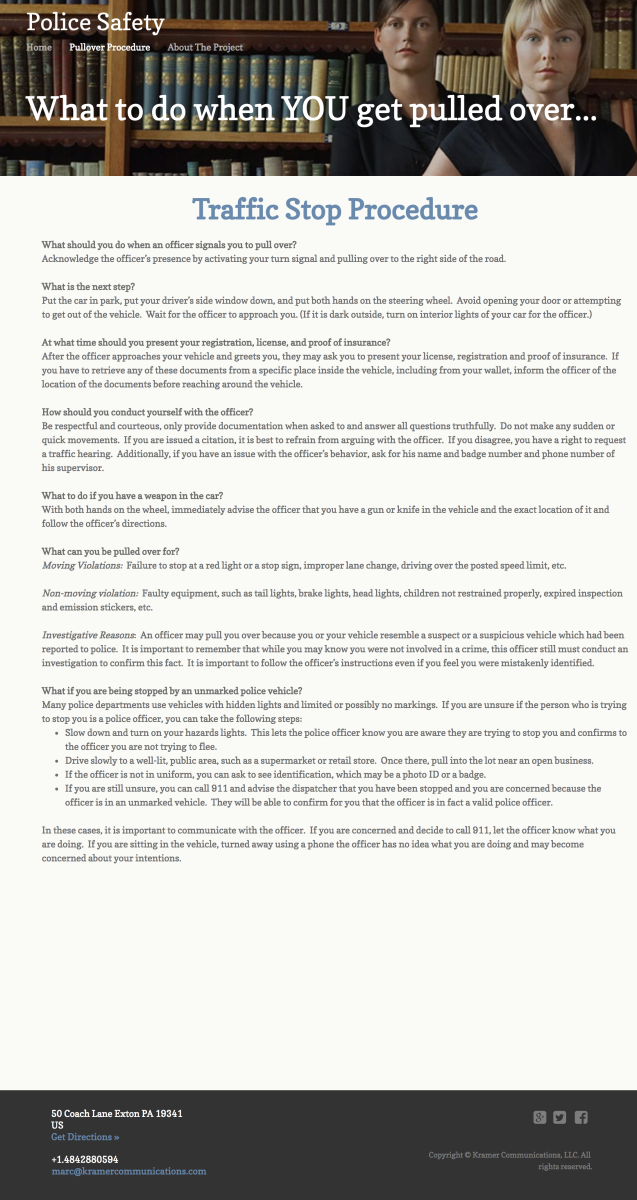Racial disparities left out of class project
After brainstorming ideas for their social entrepreneurship class, a group of 36 first-year students at Saint Joseph’s University decided to create a series of videos that would teach drivers what to do when pulled over by police.
“I thought it was an absolutely terrific idea because it’s not taught in driver’s ed and this has become an issue on a national basis,” said Marc Kramer, Executive in Residence in the Erivan K. Haub School of Business. “It’s always been kind of an issue, when people just don’t know what to do when they’ve been pulled over.”
After much discussion, planning and research, the students created a website called PoliceSafety.net. The website includes a series of instructional videos, developed with the help of the Lower Merion Police Department, which address ideas Kramer believes are not taught at the moment.
“It’s definitely fulfilling a need that’s not out there,” Kramer said. “When you took your driver’s test did anybody teach you this? Was this in the driver’s book? So the students really hit on something that was needed, regardless of the circumstances that we’ve seen. It’s something that needed to be done and they did it.”
According to a 2011 study taken from the most recent Police-Public Contact Survey released by the U.S. Bureau of Justice, an estimated 42 percent of face-to-face contacts U.S. residents had with police occurred during a traffic stop.
According to Aisha Lockridge, Ph.D, associate professor of English and director of Africana studies, the type of procedure discussed on the website is not the issue for African Americans during traffic stops.
“I don’t think the protocol is at issue,” Lockridge said. “I think it’s good to have some protocol. But I don’t think for a black person that following the protocol is what’s going to keep you safe. It’s just not. I think what’s going to keep you safe is a lot of luck.”
Austinn Reid ’18, an interdisciplinary health services (IHS) major, has been stopped multiple times by police while driving. As an African American, he understands the fear of being stopped by police.
“Parents shouldn’t even have to be educating their kids on how to act in the presence of a officer,” said Reid. “It shouldn’t be something so dangerous, and something that can ruin someone’s life in an instant. The police weren’t created to strike fear in people, but they do now.”
According to Angelique Frazier ’19, the topic of race was discussed during the creation of the project, but possibly not enough.
“Race was discussed, but I feel like it could have been maintained,” Frazier said. “I feel like it was introduced in the beginning as the reason why we’re doing this, but it’s really for all drivers. Throughout the process I feel like we lost sight of what should have been the reason for making the website.”
Lockridge shared a similar sentiment, and said that she was disappointed in the lack of acknowledgment that African American drivers are treated differently than white drivers. Lockridge also noted that the website seemed unaware and disconnected from the current moment and concluded the website was tone deaf.
Lockridge’s observations match the data collected from various current research studies, concluding that race is a factor in police interactions with drivers. Police in 100 North Carolina cities were more likely to search black and Hispanic motorists, using a lower threshold of suspicion, than when they stopped white or Asian drivers according to The Stanford Open Policing project,. The researchers created an algorithm that analyzed four and a half million vehicle stops, but also said they could not definitively conclude the disparities in the stops are because of racial bias.
Police speak to African Americans and white Americans with differing levels of respect during traffic stops according to Stanford University psychologist Jennifer Eberhardt, who led a study that examined the language used by police officers in Oakland during traffic stops.
Researchers in Eberhardt’s study examined seven days of body cam footage which recorded 918 stops in 2014. The study found that officers language was less respectful when speaking to black motorists in comparison to white motorists. White drivers were 57 percent more likely to hear respectful utterances, whereas black motorists were 61 percent more likely to hear an officer make the least respectful utterances.
This data seems to suggest that there are many more factors that minorities need to consider when getting pulled over by the police than their white counterparts.
“From a student perspective I imagine it allows [them] to oversimplify the really complicated racial politics of being stopped by the police,” Lockridge said. “I feel like this is just another pocket of safety that’s inaccurate, untrue, and re-enforces really old narratives.”
















































